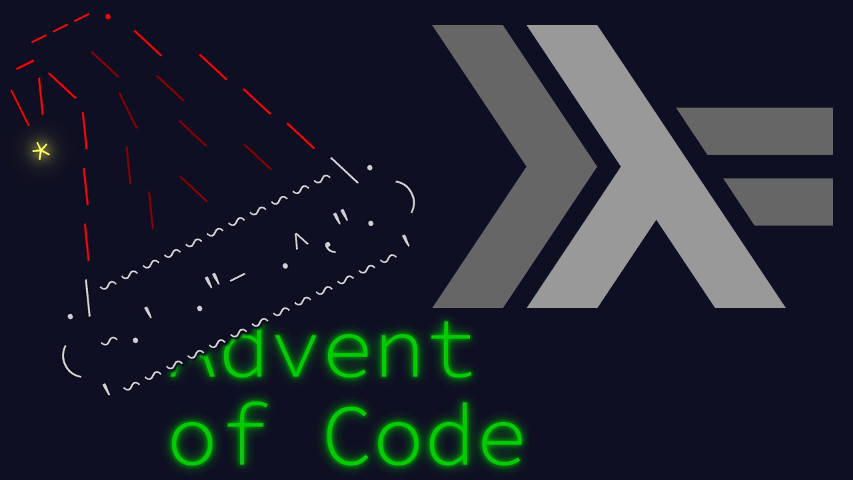Refreshingly, no 2D grid today. For Advent of Code’s 19th day, the “Linen Layout” puzzle asks us to to arrange complex stripe patterns from smaller pieces. This is literate Haskell, introduced by an import block.
import Control.Arrow ((&&&))
import Control.Monad (forM_)
import Control.Monad.ST (ST,runST)
import Data.Array.ST (STArray,newArray,readArray,writeArray)
import Data.List (tails)
import Data.Maybe (mapMaybe)Parsing is rather simple: we have the smaller pieces comma-separated on the first line; then come the target designs.
parse :: String -> ([String],[String])
parse s = (patterns,towels) where
(rawPatterns:_:towels) = lines s
patterns = words (filter (/= ',') rawPatterns)Part 1 asks us which designs are achievable using the source material.
This is exactly the kind of thing regular expressions are for. So this is exactly the kind of task I don’t run to Haskell for, reaching out for Perl instead.
my @patterns = split /, /, <>;
say 0+ grep /^(@{[join '|', @patterns]})+$/o, <>;Line 1 parses the comma-separated patterns; line 2 counts the number of remaining lines that match the following regex:
- anchored in start
^and end$of line - composed of one or more
+of the enclosed group()1 - containing the
|-joined patterns, spliced into the regex string using the babycart operator@{[]}
In part 2, we’re asked for the number of ways to achieve the arrangements. To the best of my knowledge., this is not something the common regex engines easily spit out.
So let’s use DP instead.
The main problem is: how many ways can the patterns be arranged to result in the given design?
It can be split into the following subproblem: how many ways can the patterns be arranged to result in any given prefix of the given design?
This can be solved recursively:
- the empty prefix can be constructed in exactly one way: by using exactly zero patterns.
- the number of ways any prefix can be constructed can be computed by checking which patterns match the end of the prefix, and summing the number of ways to construct the prefix without the matching pattern. Which happens to necessarily also be a prefix of the same string.
Since the dependency only goes towards shorter prefixes, we can simplify and proceed forward only by shifting the summing operation to the operation of the shorter prefix:
- we maintain an array of known counts for each prefix length
- we move left to right, checking at every position which patterns match
- for every match, we increase the array one pattern length further by the count at the current position
- when we’re done, the answer is in the rightmost array position
This translates directly to Haskell:
part2 :: ([String],[String]) -> [Int]
part2 (patterns,towels) = map dp towels where
dp towel = runST $ do
let l = length towel
a <- newArray (0,l) 0 :: ST s (STArray s Int Int)
writeArray a 0 1
forM_ (zip [0..] (tails towel)) $ \(i,suffix) -> do
cur <- readArray a i
forM_ (mapMaybe (match suffix) patterns) $ \l' -> do
let i' = i + l'
prev <- readArray a i'
writeArray a i' (prev + cur)
readArray a l…with a little helper to compute isPrefixOf and
length simultaneously:
match :: String -> String -> Maybe Int
match = go 0 where
go i (s:string) (p:prefix)
| s == p = go (i+1) string prefix
| otherwise = Nothing
go i _ [] = Just i
go _ _ _ = NothingThis computes the solution in a time proportional to the size of the patterns times the size of the designs, which is a lot better than naïve tree traversal.2
While we’re here, let’s implement part 1 in Haskell too, as a special case of part 2.
part1 :: ([String],[String]) -> Int
part1 = length . filter (> 0) . part2And a little wrapper to bind it all.
main :: IO ()
main = interact $ show . (part1 &&& sum . part2) . parseThis concludes today’s solution. See you tomorrow!
The one-or-more hack allows me to skip special-casing the separation line between patterns and designs. I’m a golfer at heart.↩︎
On particularly adversarial inputs, you’d want to match all patterns more concurrently at a given point, e.g. using a trie, so the total complexity would depend on the length of the largest pattern instead of their combined sum of lengths.↩︎



